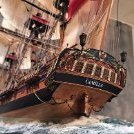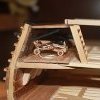-
Posts
333 -
Joined
-
Last visited
About Azzoun

- Birthday 01/01/1979
Profile Information
-
Gender
Male
-
Location
NJ
Recent Profile Visitors
-
Azzoun started following Bismarck by Jeff 59 - Trumpeter - 1/200 - PLASTIC , Christiania 1774 by TJM – approx. 1:67-1:64 – Danish Light Frigate based on Vanguard Models HMS Sphinx and WTS: Chuck Passaro’s HMS Winchelsea 1764 Chapters 1-5 and Figurehead kit in Cherry plus false keel and frames - SOLD
-
 Azzoun reacted to a post in a topic:
Syren Ship Model Company News, Updates and Info.....(part 2)
Azzoun reacted to a post in a topic:
Syren Ship Model Company News, Updates and Info.....(part 2)
-
 FrankWouts reacted to a post in a topic:
Model Machines LLC – Byrnes Model Machines - All machines to be back in production soon.
FrankWouts reacted to a post in a topic:
Model Machines LLC – Byrnes Model Machines - All machines to be back in production soon.
-
 Nirvana reacted to a post in a topic:
Model Machines LLC – Byrnes Model Machines - All machines to be back in production soon.
Nirvana reacted to a post in a topic:
Model Machines LLC – Byrnes Model Machines - All machines to be back in production soon.
-
 Canute reacted to a post in a topic:
Model Machines LLC – Byrnes Model Machines - All machines to be back in production soon.
Canute reacted to a post in a topic:
Model Machines LLC – Byrnes Model Machines - All machines to be back in production soon.
-
 druxey reacted to a post in a topic:
Model Machines LLC – Byrnes Model Machines - All machines to be back in production soon.
druxey reacted to a post in a topic:
Model Machines LLC – Byrnes Model Machines - All machines to be back in production soon.
-
 Ryland Craze reacted to a post in a topic:
Model Machines LLC – Byrnes Model Machines - All machines to be back in production soon.
Ryland Craze reacted to a post in a topic:
Model Machines LLC – Byrnes Model Machines - All machines to be back in production soon.
-
 Rik Thistle reacted to a post in a topic:
Syren Ship Model Company News, Updates and Info.....(part 2)
Rik Thistle reacted to a post in a topic:
Syren Ship Model Company News, Updates and Info.....(part 2)
-
 Dave B reacted to a post in a topic:
Syren Ship Model Company News, Updates and Info.....(part 2)
Dave B reacted to a post in a topic:
Syren Ship Model Company News, Updates and Info.....(part 2)
-
Stunning.. I love this topic, really well done!
- 144 replies
-
- Harriet Lane
- Model Shipways
-
(and 1 more)
Tagged with:
-
Hey there Bryan, may i suggest using a pin vice and hand drilling it - you'll have a lot more control and accuracy. Good Luck, Joshua
- 44 replies
-
- Nave Egizia
- Amati
-
(and 1 more)
Tagged with:
-
 Azzoun reacted to a post in a topic:
Ships in Scale Magazine Sails Again!
Azzoun reacted to a post in a topic:
Ships in Scale Magazine Sails Again!
-
 Azzoun reacted to a post in a topic:
USS St. Louis (CL-20) by highlanderburial - FINISHED - 1/200 scale - 3d Print and 1/150 Restoration
Azzoun reacted to a post in a topic:
USS St. Louis (CL-20) by highlanderburial - FINISHED - 1/200 scale - 3d Print and 1/150 Restoration
-
I ran across someone in OHIO selling this kit, left to him by his grandfather or father. Let me know if you want me to connect you two. Joshua
-
 Azzoun reacted to a post in a topic:
Start planking with gun ports, pros and cons?
Azzoun reacted to a post in a topic:
Start planking with gun ports, pros and cons?
-
 Azzoun reacted to a post in a topic:
USS St. Louis (CL-20) by highlanderburial - FINISHED - 1/200 scale - 3d Print and 1/150 Restoration
Azzoun reacted to a post in a topic:
USS St. Louis (CL-20) by highlanderburial - FINISHED - 1/200 scale - 3d Print and 1/150 Restoration
-
Excellent work recovering this damaged model Todd!
- 32 replies
-
- St Louis
- 3D Printing
-
(and 2 more)
Tagged with:
-
If you're talking about the Model Shipways kit, the brass cannon is over scale - I've scratched my own but the photos look accurate from my research. I did make mine on sleds for my own artistic license. Joshua
-
Hello to you from New Jersey!
-
Thank you for the complements. There are a few places where the fiberglass may have some raised sections which will be sanded through, some are unavoidable. The main purpose of the fiberglass is to give the hull durability and rigidity. The interior epoxy coating and all the subsequent layers of paste bondo and paint will keep the hull waterproof even if the fiberglass was sanded through in a few places. The objective is to keep it mostly intact where you can. Hope that helps. Joshua
About us
Modelshipworld - Advancing Ship Modeling through Research
SSL Secured
Your security is important for us so this Website is SSL-Secured
NRG Mailing Address
Nautical Research Guild
237 South Lincoln Street
Westmont IL, 60559-1917
Model Ship World ® and the MSW logo are Registered Trademarks, and belong to the Nautical Research Guild (United States Patent and Trademark Office: No. 6,929,264 & No. 6,929,274, registered Dec. 20, 2022)
Helpful Links
About the NRG
If you enjoy building ship models that are historically accurate as well as beautiful, then The Nautical Research Guild (NRG) is just right for you.
The Guild is a non-profit educational organization whose mission is to “Advance Ship Modeling Through Research”. We provide support to our members in their efforts to raise the quality of their model ships.
The Nautical Research Guild has published our world-renowned quarterly magazine, The Nautical Research Journal, since 1955. The pages of the Journal are full of articles by accomplished ship modelers who show you how they create those exquisite details on their models, and by maritime historians who show you the correct details to build. The Journal is available in both print and digital editions. Go to the NRG web site (www.thenrg.org) to download a complimentary digital copy of the Journal. The NRG also publishes plan sets, books and compilations of back issues of the Journal and the former Ships in Scale and Model Ship Builder magazines.







